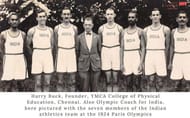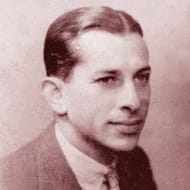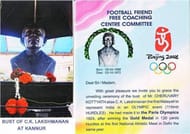Continuation of - Kerala's tryst with Olympics part 1: A sports hub called Kannur
The distinction of being the first South Indian Olympian rests on the capable shoulders of an athlete with an impeccable reputation, Major General Dr. C.K. Lakshmanan, who became the first Malayalee Olympian to participate in the Paris Olympics in 1924.
Born on the 5th of April, 1898, he grew up in a large family spanning more than 300 members of the Cheruvari Kottieth at Payyambalam, Kannur. Taking into account the fact that they had formed their own teams in football, hockey and cricket, it was to no one’s surprise that Lakshmanan demonstrated a keen interest in athletics from a very early age.
The background of this family as narrated by Ravi Bhaskar:
“My great grandfather, my maternal grandmother’s father was Choyi Butler. The term Butler is an honorific title as he owned and ran a hotel called Choyi's hotel in Kannur. I believe it has since been sold several times and the current owners have named it Choice Hotel. Choyi Butler was a man about town, who married my great grandmother and in course of time, a white lady. He sired families through both."
He added:
"For many years, the children and their white mother were never allowed inside the ancestral Kottieth House in Kannur, but after he passed away, the ice was broken and two sets of families came together. The 'white' side of the family flourished and did very well. One if not two, went on to represent India at the Olympic Games - the one that comes to my mind is C. K. Lakshmanan. Also, many did well in the armed forces, with at least one reaching the rank of Major General. No mean feat in those days. The General Raj's School in Delhi, comes from that side of the family."
Laksmanan's older brother, C. K. Vijayaraghavan also had a tale to tell. Though not connected with sports, Vijayaraghavan rose to the position of becoming the first Sergeant Major Officer of the Indian Army in 1949.
C.K. Lakshmanan, who later acquired the title of Dr. Major General, was an all-round sportsman. After completing his schooling at Kannur Municipal School, he enrolled at Madras Christian College and in due course, accomplished a professional qualification from Madras Medical College. As far as sports was concerned, he was proficient in tennis, but his preference veered towards cricket and a deeper focus was directed towards athletics.
Lakshmanan, a googly bowler by trade, played in Madras for many years and was a formidable opening bowler for them. Maharaja Kumar of Vizianagaram arranged for an exceptionally strong cricket team bolstered by the presence of the world’s greatest opening batsman, Jack Hobbs and Herbert Sutcliffe among others, to tour India and Ceylon. They arrived in Madras and it is said that C. K. Laskhmanan bowled three maiden overs against Hobbs in that match.
After the 1920 Olympics ended, it paved the way for the creation of an organization dedicated to the coordination of the Olympic movement in India. Sir Dorabji Tata was responsible for taking the initiative towards establishing a national sports body that would oversee everything from identifying and nurturing talent to promoting Olympic sport throughout the country.
He utilized his own resources to send two eminent and distinguished men to visit every part of the country and evangelize sports. The two men were A. Noehren, Physical Education Director of YMCA Physical Education College, Madras and Harry Crowe Buck who belonged to the same college faculty and was deemed the father of Indian Physical Education.

In 1923-24, a provisional All India Olympic Committee was commissioned to organize the All India Olympic Games in Delhi (which was changed to National Games of India later on) in February, 1924. Seventy athletes took part in this All India Athletic Carnival which was hyped as the greatest and most representative gathering of its kind to be held in India ever.
Every province and state in the Empire was represented at this event. C. K. Lakshmanan participated in the meeting and helped himself to a gold medal in the 120 yards Hurdles. The nine-member team was chosen for the Paris Olympics after an extensive and rigorous screening process upon conclusion of this meeting. Lakshmanan, who was 26 years old at the time, achieved selection based on his laudable performances.
A total of 44 countries, encompassing 3089 athletes (2954 Men & 135 Women) in 23 disciplines, participated in the Paris Olympics which began officially on the 5th of July and lasted till the 27th of July. It was the second time Paris hosted the Games after 1900 thus becoming the first city to host the Olympics twice.
The Olympic Stadium of Colombes (Stade Olympique Yves-du-Manoir) which had a seating capacity of 45,000 in 1924 played host to this incredible spectacle. The Olympic motto Citius, Altius, Fortius (Faster, Higher, Stronger) was used for the first time in this Olympics.
At that time, India did not possess any sports infrastructure to speak of. The only organization of note with a proven track record of promoting physical exercise and sporting activity across the country was the YMCA Physical Education College at Madras. H.C. Buck, an American who belonged to that college, excelled in athletics coaching in India.
He coached the team for a few days and assumed the role of Manager for the tight knit group upon departure to Paris. He was also the official starter at the Summer Olympics. This was the third British Indian team picked for the Olympic Competition. C. K. Lakshmanan, who secured fifth position in the heats with a timing of 16.4 seconds, was not deemed adequate to sail into the quarterfinals.
Although Indian athletes returned home empty handed, the grand gesture of having participated in the games was loudly commended in a country that had been colonized by the British for around three centuries.

C. K. Lakshmanan, who enjoyed many wins as an athlete, soon swapped his running spikes for a stethoscope. Upon the successful culmination of his higher studies in England, he returned to India to serve in the army as Major General, following which he assumed the mantle of Director General of Health Services during the British regime.
His candidature and subsequent selection as an elected member of the executive board of the World Health Organization in May 1956 was due to his close bond with Pandit Jawaharlal Nehru. That would not be the pinnacle of his career, for he rose again to become the Secretary General of the Indian Red Cross as well as the Executive Officer of the International Red Cross from July 1958 to April 1969.
He was wed to Sarojini, the daughter of his uncle, Justice Krishnan, who served as a judge at Madras High Court. They later became parents to three children, Sreelatha Khatri, Ram and Jaikrishnan. He spent the rest of his life together with his family in Delhi. On the 3rd of October, 1972, he breathed his last breath. He was 76 years old.

In the current era, sportspersons who are declared as national heroes, are often immortalized in the form of statues. A bust of C. K. Lakshmanan was unveiled by Olympian footballer, O. Chandrashekhar, on the 5th of August 2008 on the opposite side of Jawahar Stadium, Kannur. The ceremony was attended by C. K. Lakshmanan’s daughter, Srelatha Khatri, and other close relatives. The project was undertaken by the Football Front Free Coaching Center.
C. K. Lakshmanan, whose dignified sporting career indelibly changed the face of Kerala sports through his participation in the Olympics, was a dedicated and hardworking sportsman and a wonderful human being. His competitive excellence, remarkable character, good sportsmanship and high professionalism are certain to inspire many more athletes from Kerala to match or even eclipse his achievements.
